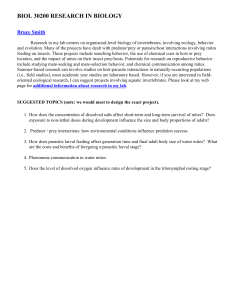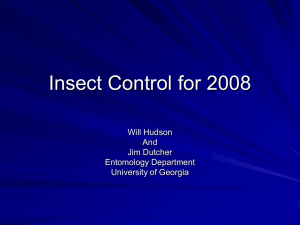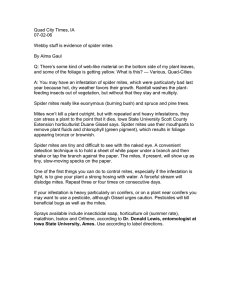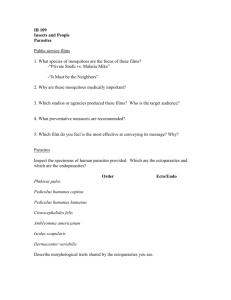jovani&serrano_j_avian_biol_04.doc
advertisement
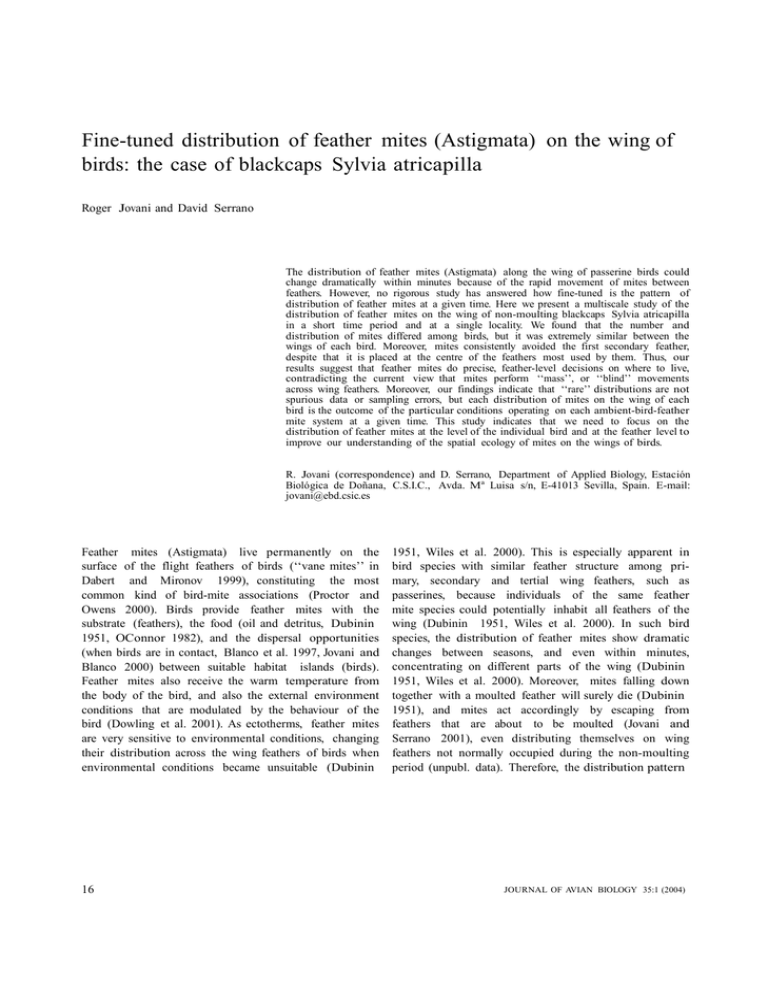
Fine-tuned distribution of feather mites (Astigmata) on the wing of birds: the case of blackcaps Sylvia atricapilla Roger Jovani and David Serrano The distribution of feather mites (Astigmata) along the wing of passerine birds could change dramatically within minutes because of the rapid movement of mites between feathers. However, no rigorous study has answered how fine-tuned is the pattern of distribution of feather mites at a given time. Here we present a multiscale study of the distribution of feather mites on the wing of non-moulting blackcaps Sylvia atricapilla in a short time period and at a single locality. We found that the number and distribution of mites differed among birds, but it was extremely similar between the wings of each bird. Moreover, mites consistently avoided the first secondary feather, despite that it is placed at the centre of the feathers most used by them. Thus, our results suggest that feather mites do precise, feather-level decisions on where to live, contradicting the current view that mites perform ‘‘mass’’, or ‘‘blind’’ movements across wing feathers. Moreover, our findings indicate that ‘‘rare’’ distributions are not spurious data or sampling errors, but each distribution of mites on the wing of each bird is the outcome of the particular conditions operating on each ambient-bird-feather mite system at a given time. This study indicates that we need to focus on the distribution of feather mites at the level of the individual bird and at the feather level to improve our understanding of the spatial ecology of mites on the wings of birds. R. Jovani (correspondence) and D. Serrano, Department of Applied Biology, Estación Bioló gica de Doñana, C.S.I.C., Avda. Ma Luisa s/n, E-41013 Sevilla, Spain. E-mail: jovani@ebd.csic.es Feather mites (Astigmata) live permanently on the surface of the flight feathers of birds (‘‘vane mites’’ in Dabert and Mironov 1999), constituting the most common kind of bird-mite associations (Proctor and Owens 2000). Birds provide feather mites with the substrate (feathers), the food (oil and detritus, Dubinin 1951, OConnor 1982), and the dispersal opportunities (when birds are in contact, Blanco et al. 1997, Jovani and Blanco 2000) between suitable habitat islands (birds). Feather mites also receive the warm temperature from the body of the bird, and also the external environment conditions that are modulated by the behaviour of the bird (Dowling et al. 2001). As ectotherms, feather mites are very sensitive to environmental conditions, changing their distribution across the wing feathers of birds when environmental conditions became unsuitable (Dubinin 16 1951, Wiles et al. 2000). This is especially apparent in bird species with similar feather structure among primary, secondary and tertial wing feathers, such as passerines, because individuals of the same feather mite species could potentially inhabit all feathers of the wing (Dubinin 1951, Wiles et al. 2000). In such bird species, the distribution of feather mites show dramatic changes between seasons, and even within minutes, concentrating on different parts of the wing (Dubinin 1951, Wiles et al. 2000). Moreover, mites falling down together with a moulted feather will surely die (Dubinin 1951), and mites act accordingly by escaping from feathers that are about to be moulted (Jovani and Serrano 2001), even distributing themselves on wing feathers not normally occupied during the non-moulting period (unpubl. data). Therefore, the distribution pattern JOURNAL OF AVIAN BIOLOGY 35:1 (2004) of feather mites on the wings of passerine birds is highly dynamic and seems mainly modulated by mite behaviour, rather than by different reproduction and survival rates of mites on different feathers. Our knowledge about the distribution of feather mites on non-moulting birds has not advanced much from the seminal monograph by Dubinin in 1951. Nowadays, it is still thought that the patterns of distribution of feather mites are the result of ‘‘mass’’, or ‘‘blind’’ movements of mites across wing feathers due to abiotic factors such as temperature, wind turbulence and humidity (Dubinin 1951, Choe and Kim 1989, McClure 1989, Wiles et al. 2000). This has caused current research on feather mites distribution to be addressed at the level of the group of feathers (i.e. primaries, secondaries and tertials), and with rough scores of mite abundance on each feather, because only ‘‘wave’’ movements of mites are expected to occur among great zones of the wing. Therefore, although we are starting to know some of the potential factors that could be shaping feather mite distribution, we neither know at which scale feather mites decide where to live, nor how fine-tuned is this behaviour. The aim of this study was to understand how fine-tuned is the distribution pattern of feather mites, posing a novel theoretical background on the study of their spatial ecology on the wing of birds. For these purposes, we made a multiscale approach to study the patterns of the distribution of feather mites on the wings of nonmoulting birds, searching for consistent patterns in the distributions among birds and between the wings of each bird. coefficient (r) estimates the fraction of total variance of the number of mites attributable to bird identity or feather position, respectively. This coefficient was easily calculated as the division between the variance of the number of mites between both wings of the same bird, or between pairs of symmetric feathers, and the total variance of the number of mites among birds and feathers using the ‘‘variance components’’ tool in SPSS 11.0. Significance of r coefficients was calculated with a one-way ANOVA (see Lessells and Boag 1987 for further details). Since the analyses of the consistency of the distribution of mites within birds could have been influenced by the absence of mites on the first primary of all studied birds (Fig. 2), we analysed our data either considering, or not considering this feather. Results All the 49 blackcaps inspected harboured feather mites. Despite of the fact that there was a high variability in mite load (median (range) = 175 (8 — 566)), the number of mites was highly repeatable between both wings of each bird (r = 0.95, F1,48 = 43.27, P B 0.0001, Fig. 1). In the same way, the distribution of feather mites along the wing differed among birds (Fig. 2), but their distribution was very similar between the wings of each bird at the feather level, both when considering all feathers (median (range) r = 0.63 (0.22 — 0.93), F1,18 = 4.44 (1.57 — 19.67), P = 0.001 ( B 0.001 — 0.1680)) and when disregarding the first primary feather (median (range), r = 0.61 (0.20 — Methods We captured 49 blackcaps Sylvia atricapilla from 10 to 18 hours on 7 and 19 December 2001 by means of mist nets placed along the side of the river Corbones (La Puebla de Cazalla, SW Spain, 37808?N, 05815?W), in a low-mountain zone dominated by patches of cultivated fields and olive forests. After capture, we kept birds individually in cloth bags, and then banded them, examined them for feather mites, and finally released them. One of us counted, one by one, all individuals of Proctophyllodid feather mites (may be more than one species) occurring on the ventral surface of each flight feather (i.e. primaries, secondaries and tertials) of both wings of each bird with the help of a 10 x lens, exposing the wing to the ambient light. We tested whether the number of feather mites was more similar between both wings of the same bird than among birds with the r intraclass correlation coefficient. The same approach was conducted for each bird separately to test the consistency of the distribution of feather mites at the feather level between the right and the left wing of each bird. The intraclass correlation JOURNAL OF AVIAN BIOLOGY 35:1 (2004) Fig. 1. Number of feather mites on the right vs. the left wing of blackcaps. 17 Fig. 2. Number of feather mites on each feather of the right (continuous line) and left wing (discontinuous line) of each of the 49 blackcaps studied. The 19 feathers are ordered consecutively on the x-axis from the tip of the wing (outermost primaries) at the left, to the inner wing feathers (tertials) towards the right. First secondary location is indicated with a vertical mark on the x-axis. 0.90), F1,17 = 4.15 (1.50 — 18.34), P = 0.002 ( B 0.001 — 0.200), see Fig. 2). It should be noted that these are conservative measurements of the consistency of the distribution of mites, since slight differences of the total number of mites between wings probably reduced the repeatability estimates. Moreover, low r-coefficients occurred only on those birds with less than 200 mites (Fig. 3), indicating that statistical, but not biological reasons, are behind low r-estimates in some birds. Although birds showed different distribution patterns of feather mites, the mites tended to concentrate on central wing feathers (Fig. 2). However, feather mite distribution showed an apparent avoidance of the most central wing feather (first secondary, Fig. 2). We performed Wilcoxon matched-pairs signed-rank tests to compare the number of mites on each first secondary feather with the neighbouring feathers, to ascertain whether this pattern was consistent among birds. As expected, we found that the first secondary harboured consistently less mites than the two adjacent feathers (Table 1). 18 Fig. 3. Relationship between the total number of feather mites on each bird and the intraclass correlation coefficient r of the distribution of feather mites on both wings. Significant and nonsignificant r coefficients are denoted in black and white dots, JOURNAL OF AVIAN BIOLOGY 35:1 (2004) respectively. JOURNAL OF AVIAN BIOLOGY 35:1 (2004) 19 Table 1. Wilcoxon matched-pairs signed-rank tests to analyse the discontinuity of the distribution of feather mites on the first secondary of the 49 blackcaps studied. S1 = first secondary (outermost secondary), S2 = second secondary, P10 = tenth primary (innermost primary). Wing P10 vs. S1 P10 > S1 P10 B S1 P10 = S1 S2 vs. S1 S2 > S1 S2 B S1 S2 = S1 Right Left Z = — 5.230, P B 0.0001 37 5 7 Z = — 4.146, P B 0.0001 32 6 11 Z = — 5.384, P B 0.0001 41 5 3 Z = — 3.935, P B 0.0001 33 10 6 Discussion The distribution of mites differed greatly among blackcaps, even with some birds having a distribution of feather mites completely opposite to others. This is especially interesting because this study was done using non-moulting individuals of the same bird species, at a single location, and during a short study period. However, the number and distribution of feather mites were highly consistent between both wings of each bird, showing for the first time that feather mites distribute themselves in the same way on both wings of a given bird at a given time. Therefore, ‘‘rare’’ distributions in a given bird-feather mite system are not spurious data or sampling errors, but the precise outcome of particular conditions operating at a given time. Therefore, we claim that the study of the distribution of feather mites at the individual bird level will surely provide new insights to the mites spatial ecology on the wing of birds, thus being a more promising approach than the study of average distributions of mites in different bird populations or species. Feather mites were found on all the flight feathers except on the first primary, but the mites tended to concentrate on the central wing feathers of most of the studied blackcaps. Surprisingly, mites consistently avoided the first secondary, which is placed in the centre of the most occupied feathers. This suggests that mites could avoid an adverse punctual phenomenon acting on one feather, irrespective of favourable conditions acting on contiguous feathers. In the case of the first secondary, some of the possible explanations could be attributed to the aerodynamic particularities of this feather, and the friction between the ventral surface (where the studied mites occurred) of the first secondary with the dorsal surface of the innermost primary when the bird folds the wings. Flight feathers of passerine birds offer feather mites a relatively homogenous habitat in terms of structure among contiguous feathers (Dubinin 1951). Thus, morphological differences between these feathers 20 seem not to be the reason behind the observed pattern. For whatever reason, this discontinuity, together with the highly consistent distribution of mites within birds, indicates that feather mites have fine-tuned patterns of distribution on the wing of birds. Overall, the conclusions of this study contrast with previous interpretations of how feather mites distribute themselves across the wing of birds. Feather mite distribution has been traditionally thought to be shaped by rough environmental factors (e.g. low temperatures and high humidity) producing ‘‘blind’’ movements of mites across the wing (McClure 1989, Wiles et al. 2000). We have previously demonstrated that feather mites are able to differentiate among feathers that have been moulted recently, feathers about to be moulted, and non-moulted feathers (Jovani and Serrano 2001), and here we have shown a highly repeatable pattern of distribution of feather mites within birds, even with sharp differences between contiguous feathers. Therefore, a feather level approach, together with individual mite counts, has proven to be a fruitful way to unravel intriguing patterns in the distribution of feather mites that otherwise would have been unnoticed. This impose a drastic methodological turn in the study of feather mites, advocating for individual counts, and statistical analyses carried out at the feather level, because fine-tuned individual decisions and not ‘‘blind’’ movements seem to be behind feather mite distribution. Acknowledgements — We want to thank Paco Rodriguez, Cristina Fuentes, Carlos Rodriguez and Esperanza Ursua for their help during pleasant field work days. José Luis Tella revised a previous version of the manuscript. The study was done under a ringing licence from the Wildlife Service of the Junta de Andalucı́a. References Blanco, G., Tella, J. L. and Potti, J. 1997. Feather mites on group-living red-billed choughs: a non-parasitic interaction? — J. Avian Biol. 28: 197 — 206. Choe, J. C. and Kim, K. C. 1989. Microhabitat selection and coexistence in feather mites (Acari: Analgoidea) on Alaskan seabirds. — Oecologia. 79: 10 — 14. Dabert, J. and Mironov, S. V. 1999. Origin and evolution of feather mites (Astigmata). — Exp. Appl. Acarology 23: 437 — 454. Dowling, D. K., Richardson, D. S., Blaakmeer, K. and Komdeur, J. 2001. Feather mite loads influenced by salt exposure, age and reproductive stage in the Seychelles warbler Acrocephalus sechellensis. — J. Avian Biol 32: 364 — 369. Dubinin, V. B. 1951. Feather mites (Analgesoidea) Part I. Introduction to their study. — Fauna SSSR Paukoobraznye 6: 1 — 363. Jovani, R. and Blanco, G. 2000. Resemblance within flocks and individual differences in feather mite abundance on longtailed tits Aegithalos caudatus. — É coscience 7: 428 — 432. Jovani, R. and Serrano, D. 2001. Feather mites (Astigmata) avoid moulting wing feathers of passerine birds. — Anim. Behav. 62: 723 — 727. JOURNAL OF AVIAN BIOLOGY 35:1 (2004) Lessells, C. M. and Boag, P. T. 1987. Unrepeatable repeatabilities: a common mistake. — Auk 104: 116 — 121. McClure, H. E. 1989. Occurrence of feather mites (Proctophyllodidae) among birds of Ventura County Lowlands, California. — J. Field Ornithol. 60: 431 — 450. OConnor, B. M. 1982. Evolutionary ecology of astigmatic mites. — Annu. Rev. Entomol. 27: 385 — 409. Proctor, H. and Owens, I. 2000. Mites and birds: diversity, parasitism and coevolution. — Trends Ecol. Evol. 15: 358 — 364. JOURNAL OF AVIAN BIOLOGY 35:1 (2004) Wiles, P. R., Cameron, J., Behnke, J. M., Hartley, I. R., Gilbert, F. S. and McGregor, P. K. 2000. Season and ambient air temperature influence the distribution of mites (Proctophyllodes stylifer ) across the wings of blue tits (Parus caeruleus ). — Can. J. Zool. 78: 1397 — 1407. (Received 19 March 2003, revised 6 August 2003, accepted 10 August 2003.) 21
